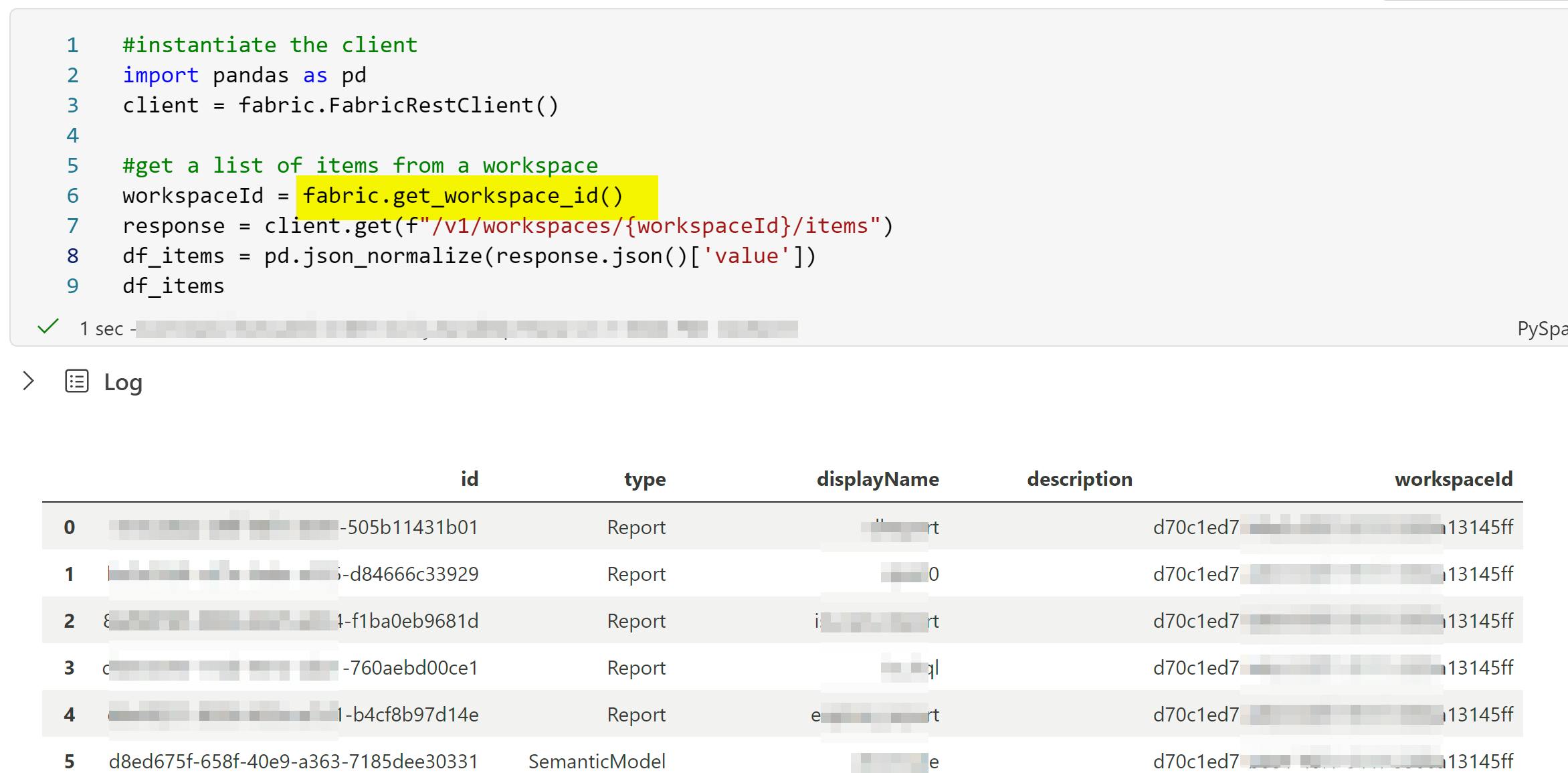Accessing Fabric REST endpoints in Fabric notebooks was already easy but it became easier and straightforward with semantic-link version 0.4.0. You can use the FabricRestClient class from sempy to set up a REST client and call the APIs. Authentication is automatically managed for you.
#sempy version 0.4.0 or higher
!pip install semantic-link --q
import pandas as pd
import sempy.fabric as fabric
#Instantiate the client
client = fabric.FabricRestClient()
Refer to the official documentation for API details. To call an API, you only need to pass the below portion of the URL.

#example usage
url = "v1/workspaces/<workspaceId>/items"
result = client.get(url)
This approach is not substantially different from using requests to make API calls, but there are a few advantages:
You don't have to generate and pass the authentication token. sempy uses the environment details to authenticate the user automatically.
This approach is similar to using
requests.Session()to maintain a persistent connection, keeping the session open longer. This is particularly beneficial if you plan to call multiple REST endpoints within the same session.sempy has a few nice utilities and functions for exception handling and getting workspace/lakehouse ids.
Example
In this simple example, I will get a list of Fabric items from a workspace. I will show how some of the utilities can help make this even easier and robust.
#instantiate the client
client = fabric.FabricRestClient()
#get a list of items from a workspace
workspaceId = "<workspaceid>"
client.get(f"/v1/workspaces/{workspaceId}/items")
In this example, I manually provided the workspace ID. However, we can obtain the notebook's workspace ID automatically without needing to define it.
#instantiate the client
import pandas as pd
client = fabric.FabricRestClient()
#get the default workspace id of the notebook
workspaceId = fabric.get_workspace_id()
#get a list of items from a workspace
response = client.get(f"/v1/workspaces/{workspaceId}/items")
df_items = pd.json_normalize(response.json()['value'])
df_items

For production use cases you will need to include exception handling. sempy provides a few nice utilities, see an example below:
import sempy.fabric as fabric
from sempy.fabric.exceptions import FabricHTTPException, WorkspaceNotFoundException
import pandas as pd
client = fabric.FabricRestClient()
def get_workspace_items(workspace=None):
"""
Sandeep Pawar | fabric.guru
Get a list of workspace items using FabricRestClient
"""
df_items = None
if workspace is None:
workspaceId = fabric.get_workspace_id()
else:
try:
workspaceId = fabric.resolve_workspace_id(workspace)
response = client.get(f"/v1/workspaces/{workspaceId}/items")
# Check the status code of the response for this endpoint
# Use 200 if operation is completed, 201 if item is created
if response.status_code != 200:
raise FabricHTTPException(response)
df_items = pd.json_normalize(response.json()['value'])
except WorkspaceNotFoundException as e:
print("Caught a WorkspaceNotFoundException:", e)
except FabricHTTPException as e:
print("Caught a FabricHTTPException. Check the API endpoint, authentication.")
return df_items
get_workspace_items("<dataflow name or id>")
In the above example:
workspace is optional. If no workspace name/id is passed,
fabric.get_workspace_id()will use the workspace id of the default workspace. Similarly, you can usefabric.get_lakehouse_id()to get the id of the default lakehouse attached to the notebook.All APIs require using workspace id. With
fabric.resolve_workspace_id(workspace)you can get the id of a workspace if the user enters workspace nameWorkspaceNotFoundException,FabricHTTPExceptionhelp catch workspace and REST endpoint exceptions.
Update: 1/21/2024
Making a POST Request
A redear asked how to make a POST request using the FABRICRestClient. Below is te example where I create a lakehouse using a POST request.
import sempy.fabric as fabric
from sempy.fabric.exceptions import FabricHTTPException, WorkspaceNotFoundException
client = fabric.FabricRestClient()
def create_lakehouse(payload:dict, workspace=None):
"""
Sandeep Pawar | fabric.guru
Create a lakehouse using POST request
"""
if workspace is None:
workspaceId = fabric.get_workspace_id()
else:
workspaceId = fabric.resolve_workspace_id(workspace)
try:
response = client.post(f"/v1/workspaces/{workspaceId}/items",json= payload)
if response.status_code != 201:
raise FabricHTTPException(response)
except WorkspaceNotFoundException as e:
print("Caught a WorkspaceNotFoundException:", e)
except FabricHTTPException as e:
print("Caught a FabricHTTPException. Check the API endpoint, authentication.")
return
#payload/body for the POST request as a dict
#example; create a lakehouse named "mylh" in the default workspace
payload = {
"displayName": "mylh",
"type": "Lakehouse"
}
#workspace name or id is optional. If None, default workspace is used.
create_lakehouse(payload=payload, workspace=None)
Thanks to Markus Cozowicz for answering my questions and for his input.
Update: 3/23/2025
Follow-up blog on using SPN authentication : Using Service Principal Authentication With FabricRestClient